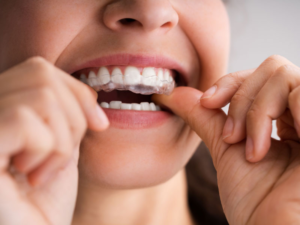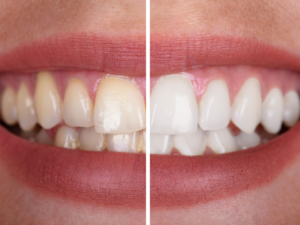
Different types of orthodontic therapies are available. Plastic aligners like Invisalign provide an alternative to traditional braces, for example. And Irving dentist Dental Concepts & Orthodontics also uses the groundbreaking Fastbraces system.
Each method may vary in terms of how long treatment takes but the basic steps of the orthodontic process are the same. This is because orthodontics is based on the biological process of restructuring bone that supports teeth. So all types of orthodontic care use oral appliances that apply gentle pressure to straighten teeth and align your bite. Here, you can find out what to expect during your orthodontic journey.
Step 1: Initial Examination
The orthodontic process begins with an initial consultation and evaluation. Your dentist will:
- Discuss your concerns with you.
- Examine your teeth and jaw.
- Use X-rays or digital imaging to detect any problems not visible to the naked eye.
Clinical examination of your teeth and jaw helps your Irving dentist recommend which type of orthodontic treatment is best for you.
We’ll talk you through everything you need to know so you can make an informed decision. This conversation will include:
- Your treatment options.
- Pros and cons of each treatment.
- How long it might take to straighten your teeth, and the costs involved.
You’ll have the opportunity to ask any questions you may have. Getting orthodontic treatment is a big decision and you need to be sure it’s right for you.
Pre-orthodontic Treatments
In some cases, the orthodontic consultation reveals oral health problems that need to be addressed before straightening your teeth.
Pre-orthodontic dental work that may be necessary includes:
- Professional teeth cleaning by a dental hygienist.
- Fillings to repair cavities caused by tooth decay.
- Root canal treatment for an infected tooth.
- Gum disease treatment.
- Tooth extraction if you have severely crowded teeth.
Step 2: Dental Impressions
Your dentist will take impressions of your mouth that will be used to make your orthodontic appliances. With conventional impressions, alginate powder is mixed with water to form a putty-like consistency. This is placed in your mouth until the material sets. It’s then used to make a dental cast of your teeth.
Digital impressions are less invasive and avoid problems such as a gagging reflex. A slim wand-type instrument called an intraoral scanner captures 3D images inside your mouth. If you’re getting Invisalign plastic aligners, digital impressions will be created by an iTero scanner using cone beam computerized tomography (CBCT).
Step 3: Your Orthodontic Treatment Starts
The third step in your orthodontic journey depends on the type of appliances you’re getting.
Placing Braces
Attaching braces to your teeth takes one to two hours and entails:
- Making sure your teeth are clean and dry.
- Applying a primer to each tooth to aid adhesion.
- Applying composite dental glue to each bracket of your braces.
- Attaching the brackets to your teeth.
- Shining a blue curing light on each bracket to speed up adhesion.
- Attaching arch wires to the brackets.
- Using rubber bands to tie the wire to the brackets.
Starting Invisalign Treatment
Getting started with Invisalign is easier because there are no metal brackets and wires or rubber bands, and the plastic trays aren’t permanently attached to your teeth. When your aligners are ready, your dentist will simply give them to you. You wear each of a series of aligners for 20 to 22 hours a day.
Step 4: Follow-Up Appointments
Whether you’ve had braces or Invisalign aligners, you’ll need to see your dentist from time to time so they can monitor your treatment. If you’re wearing braces, they’ll need to be tightened regularly, usually every four to 10 weeks. The elastics will also need changing, and the wires may need replacing.
Invisalign patients in most cases spend less time at the dental office for adjustments to their aligners. Instead, you just switch to a new set of aligner trays. However, if your treatment isn’t going to plan your dentist may need to make minute adjustments to your aligners.
Step 5: Revealing Your Newly Straightened Smile
Once your braces or clear aligners have done their job, you’ll have a straight, healthy smile. If you’ve been wearing braces, your dentist will remove them. This generally takes around one hour, including the cleaning process afterward.
Dentists use special pliers to gently squeeze the brackets of braces so they can be separated from your teeth. You might experience minor discomfort or pressure. This is normal. Step 5 is the most exciting part of orthodontic treatment, but it’s not the last. You’ll need a retainer.
Step 6: Retainers
Teeth tend to revert to their original misaligned position once braces or Invisalign treatment has been completed. To prevent this happening, it’s necessary to wear a retainer. Retainers are particularly important for adults who’ve had orthodontic treatment. The adult jaw is much stronger than that of young people whose jaws are still growing. This means greater risk of teeth shifting out of their new position.
How Long Will It Take to Straighten My Teeth?
Orthodontic treatment time depends largely on the complexity of the problem and how your teeth are straightened.
- Standard braces. Orthodontic treatment with traditional braces takes on average about two years.
- Fastbraces. As the name suggests, Fastbraces straighten teeth far more quickly than regular braces – typically in just over three months at our Irving dental office.
- Invisalign. Correcting orthodontic problems with Invisalign generally takes six to 18 months.
Pros and Cons of Different Orthodontic Treatments
Regular Braces
Standard braces remain the most effective treatment for complex orthodontic issues. Modern braces are more comfortable. They’re also less noticeable than those worn by previous generations. However, they’re still the most conspicuous type of orthodontic therapy, with longer treatment times on average.
Fastbraces
Backed by 30 years of research and development, Fastbraces typically straighten teeth faster than conventional braces or plastic aligners. They’re able to do this because the Fastbraces system streamlines the orthodontic process by moving the crowns and roots of teeth simultaneously. On the downside, Fastbraces aren’t removable, and they’re more visible than Invisalign aligners.
Invisalign
Invisalign aligners are barely if at all noticeable in the mouth. They’re also removable, which means greater comfort and convenience than fixed braces. You can enjoy all your favorite foods, and brush and floss your teeth as normal. However, Invisalign may not be an option to treat severe orthodontic issues.







